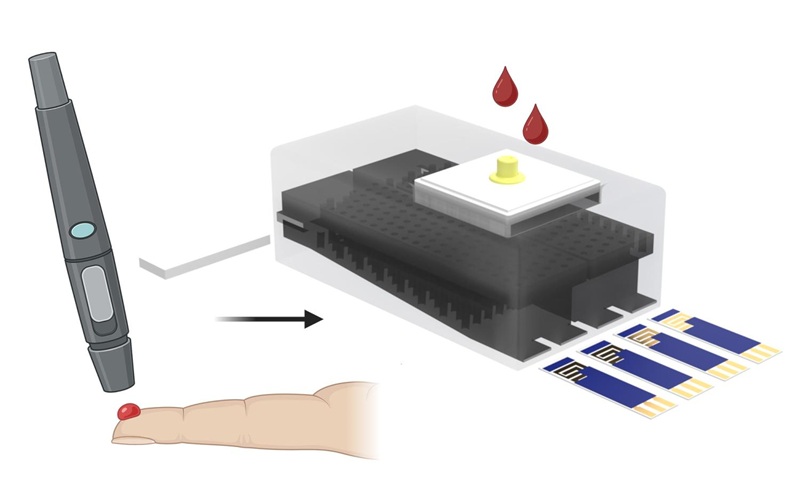Two Important Cardiovascular Disease Risk Factors Operate Independently
|
By LabMedica International staff writers Posted on 02 Mar 2022 |

Determination of blood levels of the cholesterol-rich biomarker lipoprotein(a) [Lp(a)] and the coronary artery calcium (CAC) score are independently associated with risk of developing coronary artery disease and may be useful concurrently for guiding therapy approaches to prevent its occurrence .
Lp(a) consists of a low density lipoprotein-like particle and the specific apolipoprotein(a), which is bound covalently to the apolipoprotein B contained in the outer shell of the particle. Lp(a) plasma concentrations are highly heritable and mainly controlled by the LPA gene located on chromosome 6q26-27. High Lp(a) in blood correlates with coronary heart disease (CHD) and cardiovascular disease (CVD).
A coronary CT calcium scan is a computed tomography (CT) scan of the heart for the assessment of severity of coronary artery disease. Specifically, it looks for calcium deposits in the coronary arteries that can narrow arteries and increase the risk of heart attack. This severity is presented as the coronary artery calcium (CAC) score. The CAC score is an independent marker of risk for cardiac events, cardiac mortality, and all-cause mortality. In addition, it provides additional prognostic information to other cardiovascular risk markers.
While it has been recognized that elevated Lp(a) and CAC score are individually associated with increased atherosclerotic cardiovascular disease (ASCVD) risk, the two markers have not been studied in combination. To rectify this situation investigators at the University of Texas Southwestern Medical Center (Dallas, USA) measured plasma Lp(a) and CAC at enrollment among asymptomatic participants of the MESA (Multi-Ethnic Study of Atherosclerosis) (n = 4,512) and DHS (Dallas Heart Study) (n = 2,078) cohorts. The Dallas Heart Study, an ongoing comprehensive study of diverse and heart-healthy patients, while the MESA is 6,000-participant study investigating early-stage atherosclerosis.
Results enabled identification of three distinct risk-related trends. Individuals with both elevated levels of Lp(a) and a high CAC score had the highest 10-year risk of heart attack or stroke. Those with elevated Lp(a) but with a CAC score of zero had a low 10-year heart attack and stroke risk. Finally, those with low Lp(a) but with a high CAC score had 10-year heart attack or stroke risk higher than average but lower than with high LP(a) and high CAC combined.
"We are hopeful that by making the connection between Lp(a) and CAC as dual risk drivers, we can raise awareness in the medical community and improve earlier heart attack prevention for these patients," said senior author Dr. Parag Joshi, associate professor of internal medicine at the University of Texas Southwestern Medical Center. "Our data may also expedite the development of treatments designed specifically for this high-risk population. Establishing the connection between Lp(a) and CAC means we can move to the important next phase of research, which will be defining and personalizing early screening protocols to identify patients at high risk of heart attack. With further research, this could mean selectively scanning patients with high Lp(a) for their CAC score, and studying therapies specifically designed to reduce Lp(a) among patients with high CAC."
The study was published in the March 1, 2022, issue of the Journal of the American College of Cardiology.
Related Links:
University of Texas Southwestern Medical Center
Latest Molecular Diagnostics News
- Four-Gene Blood Test Rules Out Bacterial Lung Infection
- New PCR Test Improves Diagnostic Accuracy of Bacterial Vaginosis and Candida Vaginitis
- New Serum Marker-Editing Strategy to Improve Diagnosis of Neurological Diseases
- World’s First Genetic Type 1 Diabetes Risk Test Enables Early Detection
- Blood Test to Help Low-Risk Gastric Cancer Patients Avoid Unnecessary Surgery
- First-Of-Its-Kind Automated System Speeds Myeloma Diagnosis
- Blood Protein Profiles Predict Mortality Risk for Earlier Medical Intervention
- First Of Its Kind Blood Test Detects Gastric Cancer in Asymptomatic Patients
- Portable Molecular Test Detects STIs at POC in 15 Minutes
- Benchtop Analyzer Runs Chemistries, Immunoassays and Hematology in Single Device
- POC Bordetella Test Delivers PCR-Accurate Results in 15 Minutes
- Pinprick Blood Test Could Detect Disease 10 Years Before Symptoms Appear
- Refined C-Reactive Protein Cutoffs Help Assess Sepsis Risk in Preterm Babies
- Blood Test Accurately Detects Brain Amyloid Pathology in Symptomatic Patients
- New Molecular Test Improves Diagnostic Accuracy of Lyme Disease
- New Genetic Test Enables Faster Diagnosis of Rare Diseases
Channels
Clinical Chemistry
view channel
Chemical Imaging Probe Could Track and Treat Prostate Cancer
Prostate cancer remains a leading cause of illness and death among men, with many patients eventually developing resistance to standard hormone-blocking therapies. These drugs often lose effectiveness... Read more
Mismatch Between Two Common Kidney Function Tests Indicates Serious Health Problems
Creatinine has long been the standard for measuring kidney filtration, while cystatin C — a protein produced by all human cells — has been recommended as a complementary marker because it is influenced... Read moreHematology
view channel
Platelet Activity Blood Test in Middle Age Could Identify Early Alzheimer’s Risk
Early detection of Alzheimer’s disease remains one of the biggest unmet needs in neurology, particularly because the biological changes underlying the disorder begin decades before memory symptoms appear.... Read more
Microvesicles Measurement Could Detect Vascular Injury in Sickle Cell Disease Patients
Assessing disease severity in sickle cell disease (SCD) remains challenging, especially when trying to predict hemolysis, vascular injury, and risk of complications such as vaso-occlusive crises.... Read more
ADLM’s New Coagulation Testing Guidance to Improve Care for Patients on Blood Thinners
Direct oral anticoagulants (DOACs) are one of the most common types of blood thinners. Patients take them to prevent a host of complications that could arise from blood clotting, including stroke, deep... Read moreImmunology
view channel
New Test Distinguishes Vaccine-Induced False Positives from Active HIV Infection
Since HIV was identified in 1983, more than 91 million people have contracted the virus, and over 44 million have died from related causes. Today, nearly 40 million individuals worldwide live with HIV-1,... Read more
Gene Signature Test Predicts Response to Key Breast Cancer Treatment
DK4/6 inhibitors paired with hormone therapy have become a cornerstone treatment for advanced HR+/HER2– breast cancer, slowing tumor growth by blocking key proteins that drive cell division.... Read more
Chip Captures Cancer Cells from Blood to Help Select Right Breast Cancer Treatment
Ductal carcinoma in situ (DCIS) accounts for about a quarter of all breast cancer cases and generally carries a good prognosis. This non-invasive form of the disease may or may not become life-threatening.... Read moreMicrobiology
view channelRapid POC Tuberculosis Test Provides Results Within 15 Minutes
Tuberculosis remains one of the world’s deadliest infectious diseases, and reducing new cases depends on identifying individuals with latent infection before it progresses. Current diagnostic tools often... Read more
Rapid Assay Identifies Bloodstream Infection Pathogens Directly from Patient Samples
Bloodstream infections in sepsis progress quickly and demand rapid, precise diagnosis. Current blood-culture methods often take one to five days to identify the pathogen, leaving clinicians to treat blindly... Read morePathology
view channelAI Tool Outperforms Doctors in Spotting Blood Cell Abnormalities
Diagnosing blood disorders depends on recognizing subtle abnormalities in cell size, shape, and structure, yet this process is slow, subjective, and requires years of expert training. Even specialists... Read more
AI Tool Rapidly Analyzes Complex Cancer Images for Personalized Treatment
Complex digital biopsy images that typically take an expert pathologist up to 20 minutes to assess can now be analyzed in about one minute using a new artificial intelligence (AI) tool. The technology... Read moreTechnology
view channel
AI Saliva Sensor Enables Early Detection of Head and Neck Cancer
Early detection of head and neck cancer remains difficult because the disease produces few or no symptoms in its earliest stages, and lesions often lie deep within the head or neck, where biopsy or endoscopy... Read more
AI-Powered Biosensor Technology to Enable Breath Test for Lung Cancer Detection
Detecting lung cancer early remains one of the biggest challenges in oncology, largely because current tools are invasive, expensive, or unable to identify the disease in its earliest phases.... Read moreIndustry
view channel
Abbott Acquires Cancer-Screening Company Exact Sciences
Abbott (Abbott Park, IL, USA) has entered into a definitive agreement to acquire Exact Sciences (Madison, WI, USA), enabling it to enter and lead in fast-growing cancer diagnostics segments.... Read more




 assay.jpg)


















